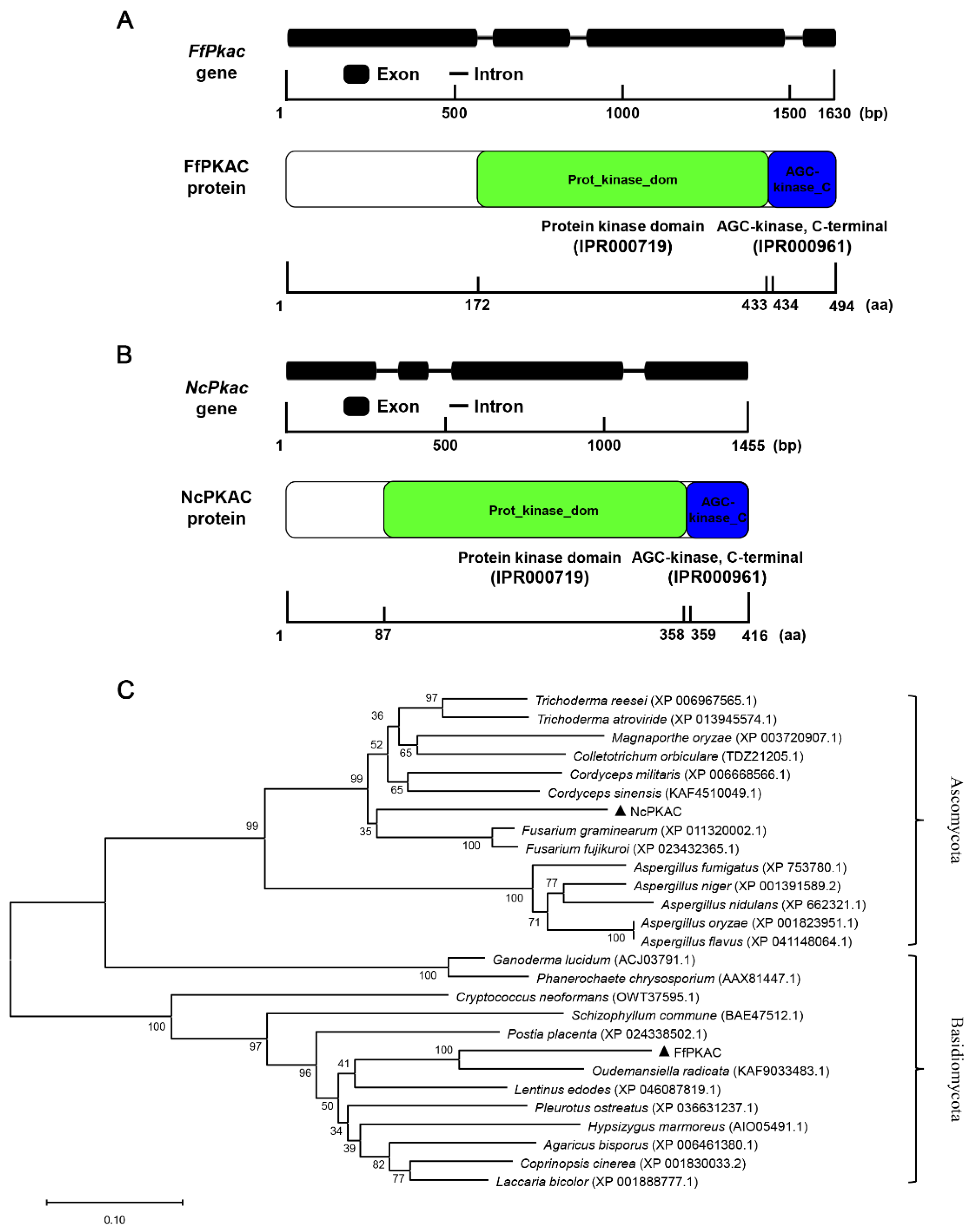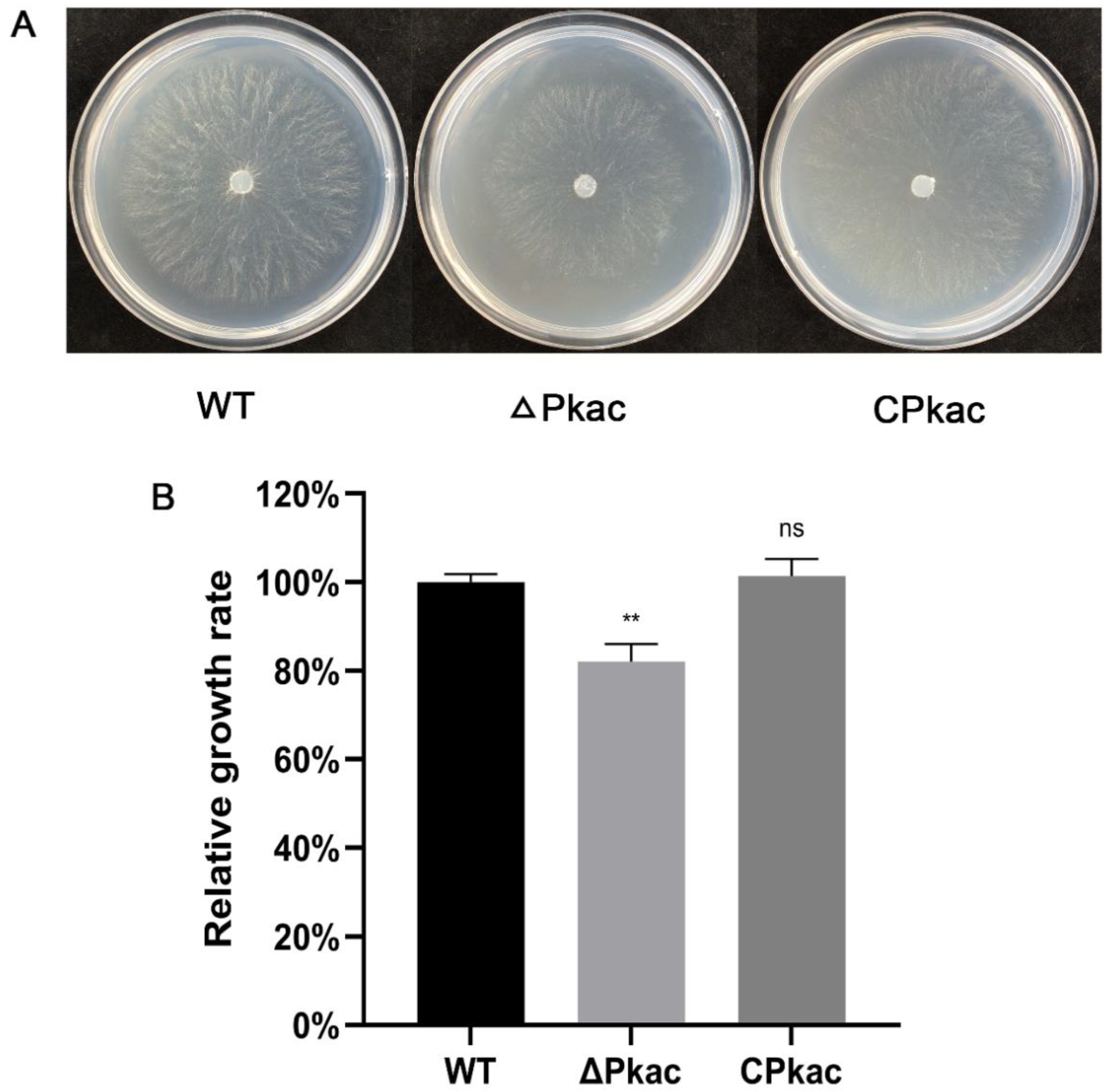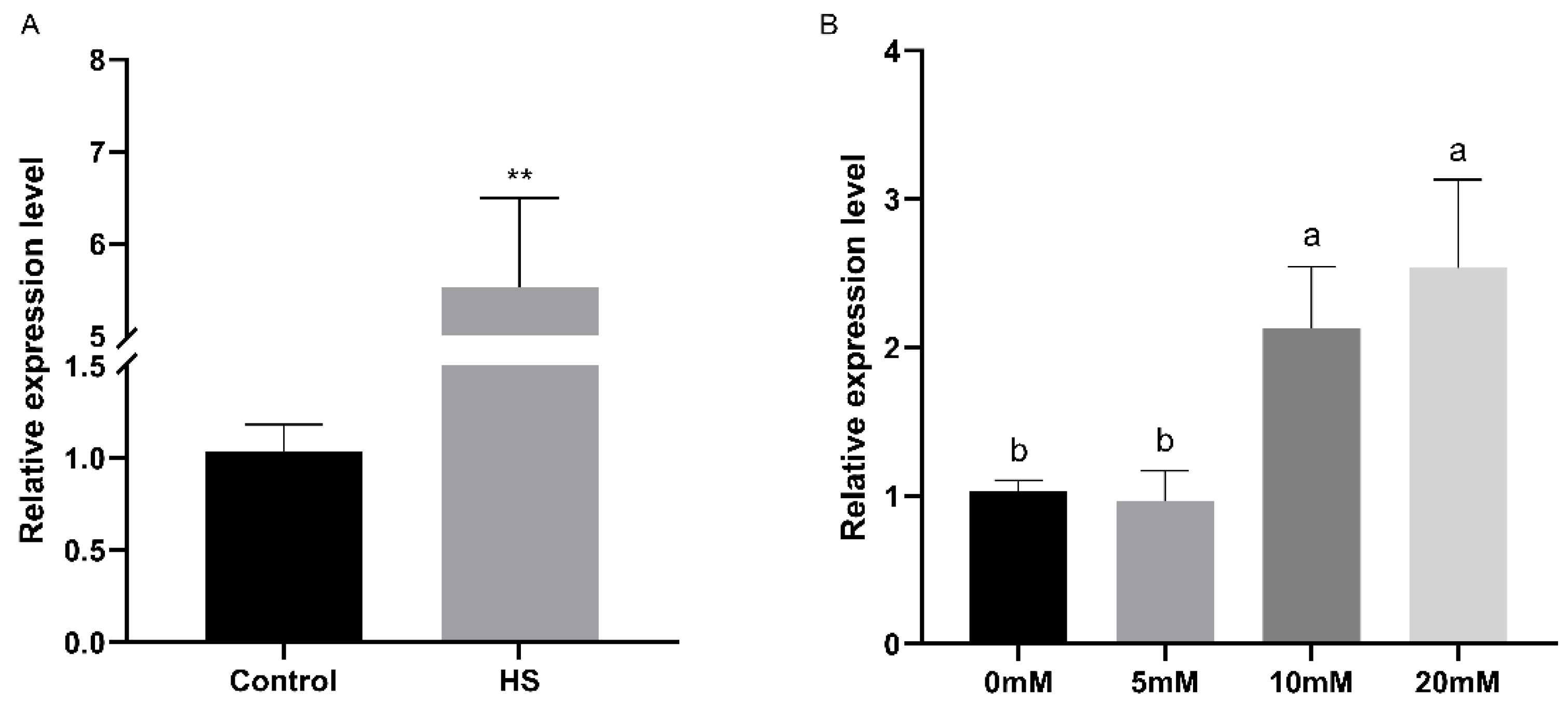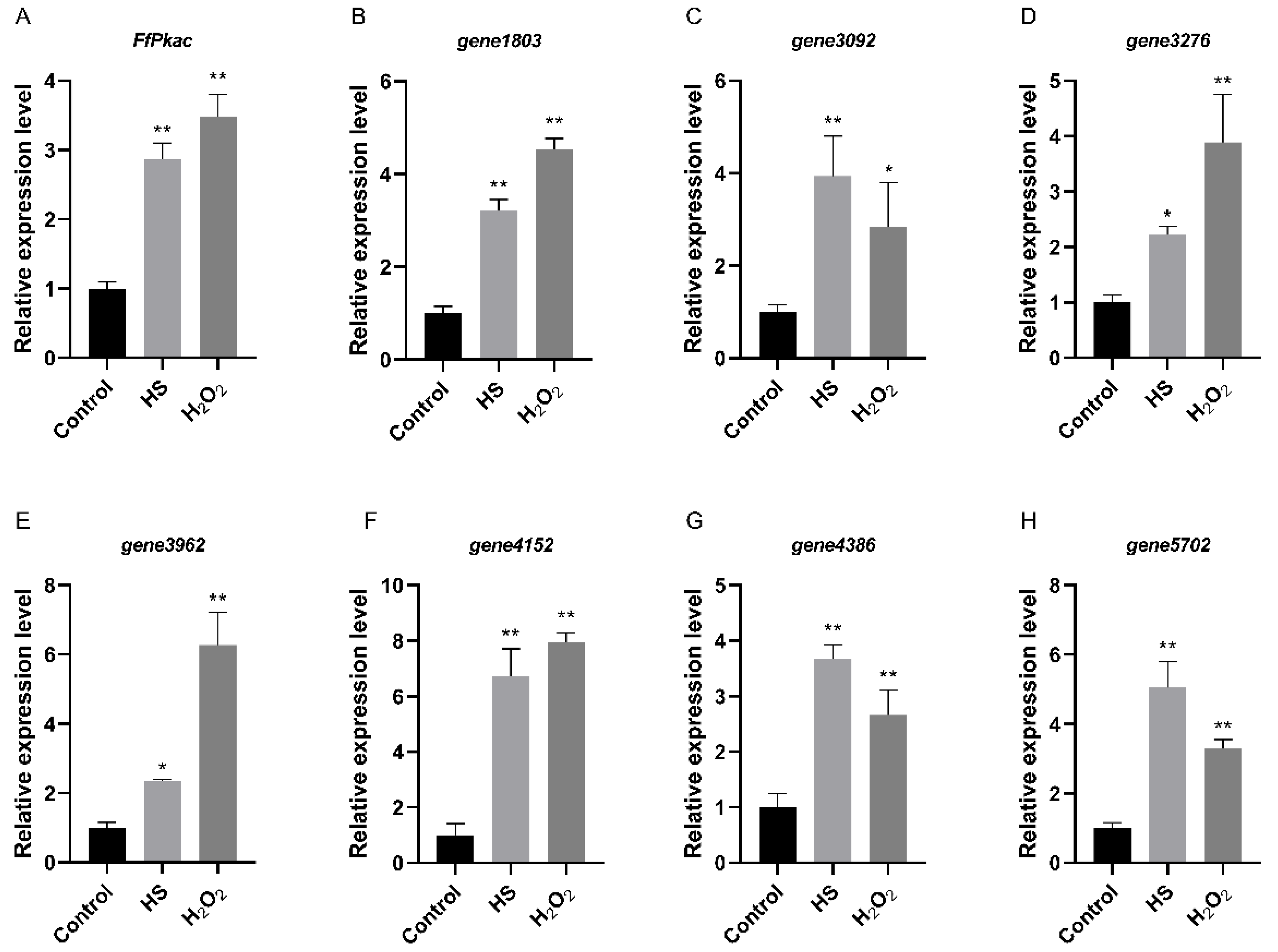Flammulina filiformis Pkac Gene Complementing in Neurospora crassa Mutant Reveals Its Function in Mycelial Growth and Abiotic Stress Response
Abstract
:1. Introduction
2. Materials and Methods
2.1. Strains and Culture Conditions
2.2. Sequence, Structure and Similarity Analysis of Pkac Gene in F. filiformis and N. crassa
2.3. Total DNA and RNA Extraction and RT-qPCR
2.4. Construction of Complementation Vector of N. crassa
2.5. RNA-Seq of N. crassa Transformants
3. Results
3.1. Structure and Protein Function of Pkac Gene
3.2. Expression Pattern of Pkac Gene
3.3. Pkac Gene Regulates Mycelial Growth
3.4. Pkac Gene Participates in Abiotic Stress Response
3.5. Identification and Validation of Downstream Regulatory Genes of Pkac
4. Discussion
Supplementary Materials
Author Contributions
Funding
Institutional Review Board Statement
Informed Consent Statement
Data Availability Statement
Acknowledgments
Conflicts of Interest
References
- Fuller, K.K.; Rhodes, J.C. Protein kinase A and fungal virulence: A sinister side to a conserved nutrient sensing pathway. Virulence 2012, 3, 109–121. [Google Scholar] [CrossRef] [PubMed]
- Yan, X.; Li, Y.; Yue, X.; Wang, C.; Que, Y.; Kong, D.; Ma, Z.; Talbot, N.J.; Wang, Z. Two novel transcriptional regulators are essential for infection-related morphogenesis and pathogenicity of the rice blast fungus Magnaporthe oryzae. PLoS Pathog. 2011, 7, e1002385. [Google Scholar] [CrossRef] [PubMed]
- D’Souza, C.A.; Heitman, J. Conserved cAMP signaling cascades regulate fungal development and virulence. FEMS MicroBiol. Rev. 2001, 25, 349–364. [Google Scholar] [CrossRef] [PubMed]
- Hu, Y.; Hao, X.; Chen, L.; Akhberdi, O.; Yu, X.; Liu, Y.; Zhu, X. Gα-cAMP/PKA pathway positively regulates pigmentation, chaetoglobosin A biosynthesis and sexual development in Chaetomium globosum. PLoS ONE 2018, 13, e0195553. [Google Scholar] [CrossRef] [PubMed]
- Li, L.; Wright, S.J.; Krystofova, S.; Park, G.; Borkovich, K.A. Heterotrimeric G protein signaling in filamentous fungi. Ann. Rev. Microbiol. 2007, 61, 423–452. [Google Scholar] [CrossRef]
- Hicks, J.K.; D’Souza, C.A.; Cox, G.M.; Heitman, J. Cyclic AMP-dependent protein kinase catalytic subunits have divergent roles in virulence factor production in two varieties of the fungal pathogen Cryptococcus neoformans. Eukaryot. Cell 2004, 3, 14–26. [Google Scholar] [CrossRef]
- Oliver, B.G.; Panepinto, J.C.; Fortwendel, J.R.; Smith, D.L.; Askew, D.S.; Rhodes, J.C. Cloning and expression of pkaC and pkaR, the genes encoding the cAMP-dependent protein kinase of Aspergillus fumigatus. Mycopathologia 2002, 154, 85–91. [Google Scholar] [CrossRef]
- Feliciello, A.; Gottesman, M.E.; Avvedimento, E.V. cAMP-PKA signaling to the mitochondria: Protein scaffolds, mRNA and phosphatases. Cell. Signal. 2005, 17, 279–287. [Google Scholar] [CrossRef]
- Li, L.; Borkovich, K.A. GPR-4 is a predicted G-protein-coupled receptor required for carbon source-dependent asexual growth and development in Neurospora crassa. Eukaryot. Cell 2006, 5, 1287–1300. [Google Scholar] [CrossRef]
- Chang, C.; Cai, E.; Deng, Y.Z.; Mei, D.; Qiu, S.; Chen, B.; Zhang, L.H.; Jiang, Z. cAMP/PKA signalling pathway regulates redox homeostasis essential for Sporisorium scitamineum mating/filamentation and virulence. Environ. MicroBiol. 2019, 21, 959–971. [Google Scholar] [CrossRef]
- Toyokawa, C.; Shobu, M.; Tsukamoto, R.; Okamura, S.; Honda, Y.; Kamitsuji, H.; Izumitsu, K.; Suzuki, K.; Irie, T. Effects of overexpression of PKAc genes on expressions of lignin-modifying enzymes by Pleurotus ostreatus. Biosci. Biotechnol. Biochem. 2016, 80, 1759–1767. [Google Scholar] [CrossRef] [PubMed]
- Choi, Y.E.; Xu, J.R. The cAMP signaling pathway in Fusarium verticillioides is important for conidiation, plant infection, and stress responses but not fumonisin production. Mol. Plant Microbe Interact 2010, 23, 522–533. [Google Scholar] [CrossRef] [PubMed]
- Gold, S.; Duncan, G.; Barrett, K.; Kronstad, J. cAMP regulates morphogenesis in the fungal pathogen Ustilago maydis. Genes Dev. 1994, 8, 2805–2816. [Google Scholar] [CrossRef] [PubMed]
- Pei-Bao, Z.; Ren, A.Z.; Xu, H.J.; Li, D.C. The Gene fpk1, Encoding a cAMP-dependent Protein Kinase Catalytic Subunit Homolog, is Required for Hyphal Growth, Spore Germination, and Plant Infection in Fusarium verticillioides. J. Microbiol. Biotechnol. 2010, 20, 208–216. [Google Scholar] [CrossRef] [PubMed]
- D’Souza, C.A.; Alspaugh, J.A.; Yue, C.; Harashima, T.; Cox, G.M.; Perfect, J.R.; Heitman, J. Cyclic AMP-dependent protein kinase controls virulence of the fungal pathogen Cryptococcus neoformans. Mol. Cell Biol. 2001, 21, 3179–3191. [Google Scholar] [CrossRef]
- Sakamoto, Y. Influences of environmental factors on fruiting body induction, development and maturation in mushroom-forming fungi. Fungal Biol. Rev. 2018, 32, 236–248. [Google Scholar] [CrossRef]
- Vogel, H.J. A convenient growth medium for Neurospora crassa. Microb. Genet. Bull. 1956, 13, 42–47. [Google Scholar]
- Tao, Y.; Chen, R.; Yan, J.; Long, Y.; Tong, Z.; Song, H.; Xie, B. A hydrophobin gene, Hyd9, plays an important role in the formation of aerial hyphae and primordia in Flammulina filiformis. Gene 2019, 706, 84–90. [Google Scholar] [CrossRef]
- Ebbole, D.; Sachs, M. A rapid and simple method for isolation of Neurospora crassa homokaryons using microconidia. Fungal Genet. Newsl. 1990, 37, 17–18. [Google Scholar] [CrossRef]
- Kumar, S.; Stecher, G.; Li, M.; Knyaz, C.; Tamura, K. MEGA X: Molecular Evolutionary Genetics Analysis across Computing Platforms. Mol. Biol. Evol. 2018, 35, 1547–1549. [Google Scholar] [CrossRef]
- Porebski, S.; Bailey, L.G.; Baum, B.R. Modification of a CTAB DNA extraction protocol for plants containing high polysaccharide and polyphenol components. Plant Mol. Biol. Rep. 1997, 15, 8–15. [Google Scholar] [CrossRef]
- Tao, Y.; van Peer, A.F.; Huang, Q.; Shao, Y.; Zhang, L.; Xie, B.; Jiang, Y.; Zhu, J.; Xie, B. Identification of novel and robust internal control genes from Volvariella volvacea that are suitable for RT-qPCR in filamentous fungi. Sci. Rep. 2016, 6, 29236. [Google Scholar] [CrossRef] [PubMed]
- Livak, K.J.; Schmittgen, T.D. Analysis of relative gene expression data using real-time quantitative PCR and the 2−ΔΔCT Method. Methods 2001, 25, 402–408. [Google Scholar] [CrossRef] [PubMed]
- Margolin, B.S.; Freitag, M.; Selker, E.U. Improved plasmids for gene targeting at the his-3 locus of Neurospora crassa by electroporation. Fungal Genet. Rep. 1997, 44, 34–36. [Google Scholar] [CrossRef]
- Pertea, M.; Kim, D.; Pertea, G.M.; Leek, J.T.; Salzberg, S.L. Transcript-level expression analysis of RNA-seq experiments with HISAT, StringTie and Ballgown. Nat. Protoc. 2016, 11, 1650–1667. [Google Scholar] [CrossRef]
- Thomas, J.G.; Olson, J.M.; Tapscott, S.J.; Zhao, L.P. An efficient and robust statistical modeling approach to discover differentially expressed genes using genomic expression profiles. Genome Res. 2001, 11, 1227–1236. [Google Scholar] [CrossRef]
- Fan, F.; Ma, G.; Li, J.; Liu, Q.; Benz, J.P.; Tian, C.; Ma, Y. Genome-wide analysis of the endoplasmic reticulum stress response during lignocellulase production in Neurospora crassa. Biotechnol. Biofuels 2015, 8, 66. [Google Scholar] [CrossRef]
- Banno, S.; Noguchi, R.; Yamashita, K.; Fukumori, F.; Kimura, M.; Yamaguchi, I.; Fujimura, M. Roles of putative His-to-Asp signaling modules HPT-1 and RRG-2, on viability and sensitivity to osmotic and oxidative stresses in Neurospora crassa. Curr. Genet. 2007, 51, 197–208. [Google Scholar] [CrossRef]
- Portela, P.; Rossi, S. cAMP-PKA signal transduction specificity in Saccharomyces cerevisiae. Curr. Genet. 2020, 66, 1093–1099. [Google Scholar] [CrossRef]
- Goncalves, A.P.; Hall, C.; Kowbel, D.J.; Glass, N.L.; Videira, A. CZT-1 is a novel transcription factor controlling cell death and natural drug resistance in Neurospora crassa. G3 2014, 4, 1091–1102. [Google Scholar] [CrossRef]
- Zheng, X.; Cairns, T.C.; Ni, X.; Zhang, L.; Zhai, H.; Meyer, V.; Zheng, P.; Sun, J. Comprehensively dissecting the hub regulation of PkaC on high-productivity and pellet macromorphology in citric acid producing Aspergillus niger. Microb. Biotechnol. 2022, 15, 1867–1882. [Google Scholar] [CrossRef] [PubMed]
- Schumacher, J.; Kokkelink, L.; Huesmann, C.; Jimenez-Teja, D.; Collado, I.G.; Barakat, R.; Tudzynski, P.; Tudzynski, B. The cAMP-dependent signaling pathway and its role in conidial germination, growth, and virulence of the gray mold Botrytis cinerea. Mol. Plant Microbe Interact 2008, 21, 1443–1459. [Google Scholar] [CrossRef] [PubMed] [Green Version]







Publisher’s Note: MDPI stays neutral with regard to jurisdictional claims in published maps and institutional affiliations. |
© 2022 by the authors. Licensee MDPI, Basel, Switzerland. This article is an open access article distributed under the terms and conditions of the Creative Commons Attribution (CC BY) license (https://creativecommons.org/licenses/by/4.0/).
Share and Cite
Yang, Y.; Xie, B.; Jing, Z.; Lu, Y.; Ye, J.; Chen, Y.; Liu, F.; Li, S.; Xie, B.; Tao, Y. Flammulina filiformis Pkac Gene Complementing in Neurospora crassa Mutant Reveals Its Function in Mycelial Growth and Abiotic Stress Response. Life 2022, 12, 1336. https://doi.org/10.3390/life12091336
Yang Y, Xie B, Jing Z, Lu Y, Ye J, Chen Y, Liu F, Li S, Xie B, Tao Y. Flammulina filiformis Pkac Gene Complementing in Neurospora crassa Mutant Reveals Its Function in Mycelial Growth and Abiotic Stress Response. Life. 2022; 12(9):1336. https://doi.org/10.3390/life12091336
Chicago/Turabian StyleYang, Yayong, Bin Xie, Zhuohan Jing, Yuanping Lu, Jun Ye, Yizhao Chen, Fang Liu, Shaojie Li, Baogui Xie, and Yongxin Tao. 2022. "Flammulina filiformis Pkac Gene Complementing in Neurospora crassa Mutant Reveals Its Function in Mycelial Growth and Abiotic Stress Response" Life 12, no. 9: 1336. https://doi.org/10.3390/life12091336




